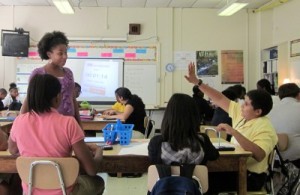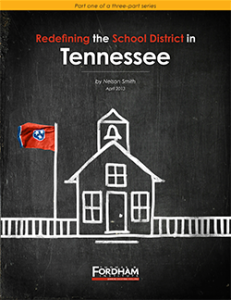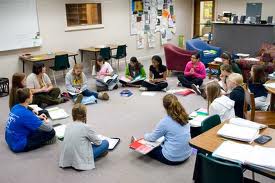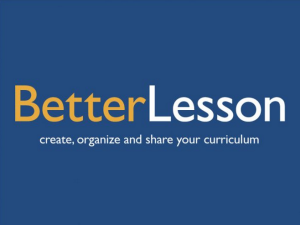Lesson Planning Articles
K-12 Lesson Planning with Common Core
NEW STANDARDS MEAN LOTS OF TALKING—AND EVEN WRITING—ABOUT MATH
Hechinger Report – 10/15/2013
Cicely Woodard has the daunting task of helping eighth-graders understand and even enjoy math. Five days a week, she leads her students at Nashville’s Rose Park Magnet Middle School through the intricacies of graphs, formulas and equations. It’s knowledge she knows they’ll need to get into college.
Even on tough days, she says, “There’s nothing in the world I would rather be doing.”
Woodard thinks her mission became a little easier this school year because of the Common Core, a set of education standards for math and English language arts that have been adopted by Tennessee, along with 44 other states and the District of Columbia.
“I am definitely a fan,” says Woodard, 35, who has been teaching for 11 years. “I am so excited by the thinking and the learning that kids are doing now, and the way that they are able to express themselves in the classroom. It’s really exciting to hear them talk and use all of the math terms to explain their thinking and construct arguments.”
On a recent Friday, Woodard began her honors algebra class by asking students their answers to homework problems. The conversation didn’t end with a number—even if it was the correct one. Students had to explain their strategies for reaching particular answers. When one boy realized he’d come up with the wrong figure, he and the rest of the class talked about why he was wrong and what he should have done differently.
A few minutes later, Woodard led a discussion of how to determine whether a problem has one solution, no solution or many solutions. She gave her students a problem to work on that had only one solution, but that didn’t mean the assignment was simple. Not only did she want students to use two different mathematical strategies to solve the problem, she also wanted them “to be able to explain your thinking using complete sentences and correct punctuation.”
A student asks Cicely Woodard a question during group work time in her class at Rose Park Magnet Middle School. (Photo: Barbara Kantrowitz)
One of the big ideas behind the Common Core is to break down barriers between subjects, encouraging students in math class to write about problems rather than merely turn in a row of numbers. “That’s what I like about Common Core,” says Woodward. “It’s all about meaning.”
The Common Core grew out of concerns from educators around the country that U.S. students were far behind their peers in countries like Singapore and South Korea on international tests. The National Governors Association and the Council of Chief State School Officers commissioned experts to devise new standards for math and English that would be based on research and would prepare students for college and careers.
Proponents say the Common Core is better than previous standards in many states because it emphasizes problem-solving and collaboration—skills students will need in the workplace. In many states, students will delve more deeply into fewer topics, allowing more time for them to grasp concepts.
 But critics have become increasingly vocal. Last month, the state Senate Education Committee held two days of hearings on the new standards, setting up a potentially contentious battle over whether Tennessee will stick with the Common Core. Speakers complained that the standards were part of an effort by the federal government to collect extensive data on students, and that they represented a threat to states’ rights. The standards were also attacked by some speakers for being too lax, while others said the Common Core might be too rigorous for struggling students.
But critics have become increasingly vocal. Last month, the state Senate Education Committee held two days of hearings on the new standards, setting up a potentially contentious battle over whether Tennessee will stick with the Common Core. Speakers complained that the standards were part of an effort by the federal government to collect extensive data on students, and that they represented a threat to states’ rights. The standards were also attacked by some speakers for being too lax, while others said the Common Core might be too rigorous for struggling students.
Tennessee officially adopted the standards in 2010 and began phasing them in over the past three years. In the 2011-12 school year, most districts started using the Common Core standards in kindergarten through second grade. Last year, according to the state education department, school districts used the Common Core math standards in grades 3-8, and about half of the state’s districts took part in a program to pilot the language arts standards. This year, the state is using the standards in all grades.
“I love the fact that at this age, they can still fall in love with math. They can still change their minds about it.” –Cicely Woodard
Over the past year, Woodard has become something of an expert on Common Core math. In the summer of 2012, she attended Common Core training sessions that the state ran for eighth-grade math teachers. But she says her teaching practice didn’t really change until last December, when she started training to become a coach for Algebra I this past summer. “I learned more about how to apply the standards,” she says.
After training weekends in March and April, she felt transformed. Woodard remembers coming home after the April training exhausted but inspired. “I really wanted to rest,” she says, “but my mind kept turning about how I could change this lesson that I was going to do the very next day. I didn’t want to do it the way I had planned. After that training, I knew how to fix it.”
Woodard learned to ask questions of students that could get at how well they understood the lesson and found that having students work on problems in groups helped them figure out solutions together. “The whole idea of them talking more than me was important,” she says. “I needed to be the facilitator and not the lecturer.”
Woodward had a chance to pass those lessons on this summer as one of about 700 coaches training 30,000 teachers around the state. Emily Barton, Tennessee’s assistant commissioner of curriculum and instruction, has been overseeing the state’s switch to the Common Core. Barton says that by the end of the summer, about half of the state’s teachers had been trained.
Teachers who didn’t attend the sessions can learn about the standards through webinars and other tools on the state’s Common Core website, Barton says, and by working with other teachers in their schools who have been trained.
The change to a new way of thinking and teaching hasn’t been easy. At Rose Park, instructional coach Sarah Shepherd says the Common Core standards challenge teachers who have grown used to another way of doing things. “It really forces the teacher to become more engaged, and the children to engage with each other,” she says.
Because the Common Core is just being introduced statewide this year, it’s too soon to tell whether it will live up to the potential its proponents see in it. Some critics worry that it’s just one more “reform” imposed on the state in recent years by the federal government or other outsiders. Tennessee was one of the first two states to win a Race to the Top grant ($501 million in 2010). At the time, Gov. Bill Haslam called the state “the focal point of education reform in the nation.”
A recent report by the group Broader, Bolder Approach to Education, however, found that Race to the Top in Tennessee and other states didn’t significantly raise student achievement.
Will the Common Core be better?
“I have no confidence that this is it,” says state Rep. Joe Pitts, a Democrat from Clarksville. “In fact, I fully expect something else. It’s like the latest, greatest shiny thing and it’s new, so let’s try it.”
Other critics worry that the standards are too complicated for students who typically struggle. But Woodard and her fellow Rose Park teachers are more optimistic. Their school is a good testing ground because it draws from all over Nashville, with about two-thirds of students qualifying for free or reduced-price lunch, according to Assistant Principal Jackie Freeman.
Having the kids speak up more in class gives Woodard a better sense of how well they understand specific concepts. If she sees a problem, she can help on the spot. “I think it is about setting high expectations and believing that they can do it,” Woodard says.
Over a recent lunch, members of the eighth-grade teaching team—Woodard, science teacher Claudeen Denning and history teacher Sue Braswell—described why the new standards felt liberating. They especially like the interdisciplinary approach. Braswell was proud that her students were using original sources in writing projects, and Denning said she felt classroom discussions helped students enjoy science more.
All of them see middle school as a special opportunity. “I love the fact that at this age, they can still fall in love with math,” says Woodard. “They can still change their minds about it.”
GETTING TEACHERS TO SHARE NICELY
Biomes, from Open Curriculum
Most teachers have file folders and flash drives full of material that they use to generate awesome lessons year after year: activities, projects, discussion questions, texts, audio, video. But they don’t always have easy ways to share these ideas, or discover new ones.
A new non-profit ed-tech start-up called Open Curriculum based in Pittsburgh, launches this week aiming to change all that by focusing on the ease of creation and building local communities of sharing. It’s designed to work as a place where teachers can easily create, edit and exchange textbook-style content and step-by-step lesson plans.
sharing. It’s designed to work as a place where teachers can easily create, edit and exchange textbook-style content and step-by-step lesson plans.
“YouTube made the creation and sharing of videos a much easier process,” says founder Varun Arora. “We’re trying to nail creation for educational content.”
There are lots of other versions of this idea out there: Share My Lesson is backed by the UFT, Better Lesson was created by a Teach for America alum, and Teachers Pay Teachers has the unique take of having teachers buy and sell lessons rather than sharing for free.
Open Curriculum is trying to differentiate itself by focusing on the nuts and bolts of creating and sharing resources, and the development of local communities of sharers.
Github, a website where developers can collaborate on open-source software projects, enables “forking” and easy control over many different versions of a single program. OpenCurriculum uses super-simple language and a web-first interface to allow teachers to do the same thing. You ![]() can upload using Dropbox, Facebook, or Gmail or create projects directly in the browser.
can upload using Dropbox, Facebook, or Gmail or create projects directly in the browser.
 Making cool learning resources is one part of the problem OpenCurriculum is trying to address. The other issue is finding them. In simplistic terms, the Internet enables anyone t0 learn anything about anything. In practice, that too often means Wikipedia. Tons of Creative Commons-licensed educational content is out there, in “Open Educational Resource” repositories maintained by leading institutions, but it’s often hard to find, hard to browse, hard to adapt and therefore hard to reuse. The anemic reuse of open educational content has been a perennial issue since the beginning of the movement ten years ago, and there’s been a move to shift from talking about open educational resources to talking about open educational practices – what has to happen in schools in order for open educational resources and open learning to be a robust part of education.
Making cool learning resources is one part of the problem OpenCurriculum is trying to address. The other issue is finding them. In simplistic terms, the Internet enables anyone t0 learn anything about anything. In practice, that too often means Wikipedia. Tons of Creative Commons-licensed educational content is out there, in “Open Educational Resource” repositories maintained by leading institutions, but it’s often hard to find, hard to browse, hard to adapt and therefore hard to reuse. The anemic reuse of open educational content has been a perennial issue since the beginning of the movement ten years ago, and there’s been a move to shift from talking about open educational resources to talking about open educational practices – what has to happen in schools in order for open educational resources and open learning to be a robust part of education.
I’ll give a simple example. My cousin was teaching a college art history course, and she spent dozens of hours assembling her slides. In theory, she could have saved that time by adapting other slideshows created in previous years by other people teaching the same or similar courses. But first of all, she didn’t think of that. Secondly, she didn’t know where to find the other slideshows, thirdly, she didn’t know how to easily customize them. Finally, she also couldn’t share her completed slideshow freely because of copyright issues with contemporary artworks.
It turns out that local academic cultures may be hugely important to sharing. Arora, a graduate of Carnegie Mellon in Pittsburgh, studied the One Laptop Per Child program, trying to figure out why the ambitious technology giveaway hadn’t had more of an impact on learning in countries around the world.
“We realized the problem was no locally relevant content,” he says (a common criticism of the OLPC Program in various implementations around the world). It’s not just about language–teachers  need lesson plans that fit local ideas and academic requirements. “K-12 especially is very specific to certain areas.” This would seem to work against the “universal” premise of sharing free and open learning resources. But Open Curriculum is reaching out to local education communities in Pittsburgh, where they’re based, as well as South Africa and Nepal. The idea is that once teachers get the hang of pooling resources and collaborating locally, the sharing bug will spread.
need lesson plans that fit local ideas and academic requirements. “K-12 especially is very specific to certain areas.” This would seem to work against the “universal” premise of sharing free and open learning resources. But Open Curriculum is reaching out to local education communities in Pittsburgh, where they’re based, as well as South Africa and Nepal. The idea is that once teachers get the hang of pooling resources and collaborating locally, the sharing bug will spread.
Since “Speaking and Listening” are now key elements of the Common Core Standards K-12 curriculum will need to specifically incorporate elements to encourage in-class interactivity between not only teacher and student but also between student to student.

Recent Comments